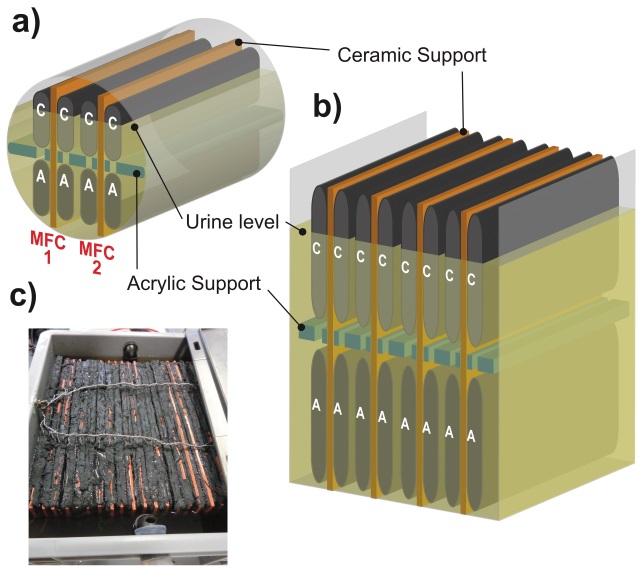Exploration and discovery
A geomicrobiologist by background, my interest was always in the study of natural stratified microbial ecosystems. Passionate about the study of the relationship between the different biological compartments of a given ecosystem, I wanted to understand how organisms mutually adapt to their environment and how they subsequently shape their surroundings.
Whilst studying stratified microbial ecosystems, I always had in the corner of my mind the desire to create artificial complex microbial ‘ecosystems’ that could help reduce the impact of human activities on the environment. Since microbial fuel cells (MFCs) are a bio-electrochemical technology converting organic waste into electricity, this field of study immediately caught my interest.
Even though the first MFCs were built by M. C. Potter in 1911, this research field only started to really develop in the 90’s. Hence, it is a relatively young area of research with a lot of opportunity for exploration and discovery!
How does this work?
The MFC is a technology in which microorganisms employ an electrode (the anode) as the end-terminal electron acceptor in their anaerobic respiration. This results in the direct transformation of chemical energy (reduced organic matter) into electrical energy, which in turn means that anything from wastewater to urine can be used as fuel.

The technology’s intrinsic characteristics are: low power (compared to established technologies), a wide range of organic matter (otherwise considered waste) which can be used as fuel, low fiscal and maintenance costs, durability and robustness.
Exploitable power is reached when assembling multiple individual MFC units into stacks. In that context, the size of individual MFCs plays an important role in the performance of the collective.
Although units can be enlarged, this affects the power density.
Although units can be enlarged, this affects the power density. This is primarily due to diffusion limitations and sub-optimal volume-to-surface-area ratios, meaning the power density is lowered.
To date, the only way to obtain high power densities was to employ small MFCs, which maximally exploit the active surfaces where the microbial biofilms transfer electrons. To reach exploitable power however, an enormous number of units is needed.
Hence, being able to increase the size of the units with limited power density losses is a major obstacle to retaining the technology’s deployment at the industrial scale for out-of-the-lab applications.
Scaling up without losing energy
To overcome the power density losses due to size increase, our main goal became to increase the bio-interfaces, as a fixed ratio to that of smaller units. Indeed, having multiple microenvironments means that increasing unit size does not increase diffusion limitations, since at the electroactive scale, all interfaces and diffusion distances would be kept at a minimum.
However, in order to maximize bio-interfaces within a fixed volume, a novel design of MFC was needed. Electrical power generation mainly resides in the difference of redox potential between an anode and a cathode. Hence the multiplication of these redox gradients (between anodes and cathodes) was the challenge.

Having in mind the need for simplicity and low cost, we were inspired by stratified microbial ecosystems. For example, when certain lakes become stratified during the summer, we observe that the various microbial communities are stratified along the oxic/anoxic interface of the water column, depending on their specific metabolisms (along a gradient of elements at different redox states).
Following on from that observation, we recreated an environment whereby the activity of microorganisms allowed a water column (urine in our case) to self-stratify, with an oxic upper part and an anoxic bottom part.
By doing so, a difference of redox potential was created between these two liquid layers. A number of cathodes could then be placed in the upper part of the urine column whilst a number of anodes could occupy the bottom part.
The result is a novel MFC design with all its anodes and most of its cathodes submerged in the same electrolyte – without short-circuiting. The obtained simplified and inexpensive design is shown to allow scale-up with limited losses in power density. The obtained stack was also shown to be stable and powerful: the power from this design is in the high range of existing, more complicated designs.
What could the future bring?
Over the last three decades, research in MFCs has focused on:
1) improving the power density of individual units
2) reducing the cost of each unit
3) widening potential fuels
4) demonstrating the implementation of this biotechnology into practical implementations
The future of this research lies in pursuing the above points. However, having MFCs which can be scaled-up to match their intended use opens new avenues in terms of applications.
The deployment of the technology can now be tested against real usage conditions: as a power source for off-grid, remote areas; as an energy efficient way of treating human organic wastes; or as self-sufficient biosensors.
Xavier Alexis Walter
Latest posts by Xavier Alexis Walter (see all)
- Power to the pee-ple - 10th May 2016

Comments